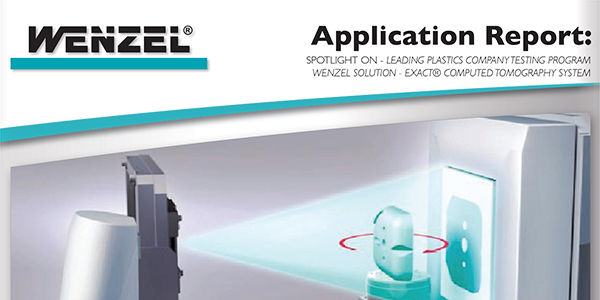
CHALLENGE: SKZ, a leading German plastics research, testing and training center needed a non-destructive and highly accurate CMM inspection method for plastic composite parts used in automotive, furniture and construction applications.
SOLUTION: Using WENZEL’s exaCT® Computed Tomography systems they’ve developed a holistic testing process for determining material and joining method quality for diverse plastic and composite parts.
Testing of welded joints on fiber composite parts
The German plastics research, testing and training center, SKZ, takes a leading role for the industry in the development of new fiber-reinforced materials. SKZ not only uses state-of-the-art manufacturing methods, but also new technologies in the field of CMM inspection and testing. For different problems and quality analysis two exaCT computed tomography systems from WENZEL are in use.
Alongside its wide range of seminars and training courses for industry experts, testing of plastics products and materials, SKZ also develops and tests new composite materi als. One of their department of R&D’s developments are Wood Plastic Composites (WPC).
Wood-Plastic-Composites are unique thermoplastic, processable, reinforced materials. They can consist of different portions of wood, plastic and additives. They are often used in the construction sector, but also in the automotive and furniture industries. These materials distinguish themselves by their excellent three-dimensional plasticity. Compared to derived timber products WPCs have high resistance to humidity and ultraviolet light and have a significant greater stiffness compared to unreinforced plastics.
To produce salable products like window frames, housings, endplates, connecting components for kitchens or coverings in the automotive industry joining methods have to be used. Currently, SKZ is testing thermal welding and adhesive bonding as joining methods.
Errors in the joining area can turn the welded joint into a weak spot of the WPC part. This would affect the durability dramatically. Consequently there is a great interest in the plastics industry in testing thermal and adhesive-joined components.
The exaCT® Computed Tomography systems from WENZEL make a holistic part analysis possible. With industrial computed tomography a complete three dimensional reconstruction of the test object can be created. Based on this reconstruction small inner structures and defects can be analyzed without destroying the object. For the CT-scan the object is placed inside the computed tomography system between x-ray tube and detector (figure 1). The test object is turned 360° in steps. After every step a two dimensional x-ray image on the detector is created. These are called projections. All two dimensional images are used for the reconstruction of the three dimensional volume-model. From this volume-model surface data is created, which is the basis for all following evaluations.
The exaCT® Computed Tomography CMM inspection system at SKZ are used for the analysis of welded joints of wood fiber composite materials. With CT data the quality of welded joints can be evaluated. Critical criteria are the spatial orientation of the wood particles, voids, inclusions and the substance-to-substance binding of the seam.
Figure 3 shows a sectional view of a test object made of wood-fiber-composite material (figure 2). This object is joined by ultrasonic welding. The material mix and the wood fiber have different densities. Therefore the wood particles are clearly visible in the plastic component of the WPC (figure 3). A visual analysis of these sectional views allows an evaluation of the quality of the welding joint. If the wood particles are perpendicular to the welding seam it will most likely result in greater stiffness. Whereas, when they are parallel to the welding seam, oriented wood particles suggest a less stiff bonding.
Defects in welding seam are analyzed in the following stage of the analysis. The evaluation software can recognize inclusions automatically and assign them to different categories of size by color coding (figure 4).
The method makes a complete and non-destructive analysis of defects through the evaluation of the number, distribution and size of inclusions occurring . The results of the analyses are used for the evaluation of quality and applicability of the combination of woodfiber- composite material used and the joining method as well.
About the SKZ Plastic Center
SKZ is the number one solution when it comes to plastic. It is Germany’s largest plastic institute and offers a myriad of solutions for the industry. SKZ has partnered with the plastics industry for more than 50 years. SKZ employs about 270 people. With quality testing and assurance it supports the product policy of its customers and valuable arguments for the markets. It is the market leader in qualifying specialists and knowledge transfer in the plastics field, with more than 10,000 participants every year. As an innovative plastics researcher it is known for market-driven developments and optimizations of products and production.
Interested in getting your part checked?
